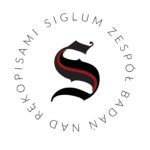
Manuscripts through the Lens: SIGLUM Research Project at the 1st International Humanities Congress
 On Wednesday, 7 December 2022, 15:00-17:30 Research Group for the Study of Manuscripts SIGLUM will be presenting several ongoing projects during the 1st International Humanities-Society-Identity Congress (WN UW, ul. Dobra 55). The projects exemplify an interdisciplinary and innovative nature of our research based on collaborative efforts from linguists, codicologists, chemists, and physicists to explore the unknown, hidden or opaque aspects of the source texts and their carriers – manuscripts. In the second part of our session, several SIGLUM members will talk about their individual research encompassing manuscripts from different periods and different geographical and cultural areas. Please, see below for the programme of our session and the conference abstracts. More details concerning the congress and our session can be found at Congress WN. Please, come and join us on Wednesday at 15:00.
On Wednesday, 7 December 2022, 15:00-17:30 Research Group for the Study of Manuscripts SIGLUM will be presenting several ongoing projects during the 1st International Humanities-Society-Identity Congress (WN UW, ul. Dobra 55). The projects exemplify an interdisciplinary and innovative nature of our research based on collaborative efforts from linguists, codicologists, chemists, and physicists to explore the unknown, hidden or opaque aspects of the source texts and their carriers – manuscripts. In the second part of our session, several SIGLUM members will talk about their individual research encompassing manuscripts from different periods and different geographical and cultural areas. Please, see below for the programme of our session and the conference abstracts. More details concerning the congress and our session can be found at Congress WN. Please, come and join us on Wednesday at 15:00.
15:00-17:30 Research Group Session 4
Research Group for the Study of Manuscripts SIGLUM
Manuscripts through the Lens: SIGLUM Research Project
Part I
Reconstructing a fragmentary psalter from early England – new pieces of the puzzle
M. Opalińska (University of Warsaw), P. Pludra-Żuk (Polish Academy of Sciences), B. Wagner (University of Warsaw), J. Karasiński (University of Warsaw)
This talk presents a collaborative project of linguists, physicists, and chemists aimed at analyzing several manuscript fragments found recently in C. Norwid Library in Elbląg. The fragments were used as endleaf guards in the binding of an early printed book from the collection of Samuel Meienreis – a 16th-century bibliophile and theologian from Elbląg. Historical, linguistic, and palaeographical analyses indicate that the new findings match other fragments dispersed in three different European libraries. All of the fragments were once part of an 11th-century Latin psalter made in England. Although each snippet provides only a fraction of data, cumulatively, they form a complex network of clues that shed light on the structure and provenance of the original book. The project involves a comprehensive analysis of all the fragments and focuses on linguistic, palaeographical, and material aspects of the sources. We will talk about the non-invasive physical and chemical analyses of the ink and pigments applied so far, and a digital reconstruction of the fragmented leaves carried out in collaboration with Fragmentarium.
Merkuryjusz polski by Jakub Kazimierz Haur, BUW sygn. 191 – an interdisciplinary approach
A. Fabiańska (University of Warsaw Library), J. Partyka (PAN), B. Wagner (University of Warsaw)
Jakub Kazimierz Haur was working on Merkuryjusz polski for at least several years. In the course of his work, he changed the concept and added glosses to individual entries. Whenever the changes were substantial, he pasted notes with revised versions onto manuscript leaves. We can trace these changes because the authorial manuscript has been preserved – it is currently held in the Special Collections at the University Library in Warsaw (MS 191). The first scholarly edition of Haur’s versified compendium has been recently published. The editorial project raised questions concerning the changes of individual entries, the exact dating of the manuscript, and the number of copyists involved in the process. A preliminary analysis has already provided some clues: the inks have been analyzed and scribes’ hands identified. In addition, the sealed parts of the text have been x-rayed and scanned by a CT scanner. In this paper, project members will present the results of the analysis and talk about the research methods applied so far.
Part II
Reading the manuscripts of the Kite by Noyan Qutuγtu Rabǰai
M. Szpindler (University of Warsaw)
Noyan Qutuγtu Rabǰai (1803–1856), a Buddhist “crazy saint” and poet from Mongolia is a well-known figure to the Mongols and Mongolists. However, most of his literary works have been known thanks to the modern publications. Presumably, none of his writings (or hardly any) have been subject to philological scrutiny or a critical edition. The aim of this paper is to partially fill this gap by presenting a critical analysis of one the most famous Buddhist teachings by Rabǰai the Kite (mong. Čaγasun sibaγu, literally meaning ‘Paper bird’), based on a reading from selected manuscripts.
What is a raqam? Looking at the Safavid bureaucratic practices through the lens of Monshaʾat-e Vahid-e Qazvini
S. Jaśkowski (University of Warsaw)
Monshaʾat of Vahid-e Qazvini is a well-known Safavid compendium of epistolography (monshaʾat). The present paper looks into this work to explore the meaning of the term raqam in the late Safavid bureaucracy. While the said term was used to refer to official documents, in general, according to the Safavid manuals of administration, it could also have a more narrow meaning – that of a document penned under the authority of majles-nevis (“court writer”). Monshaʾat is an important source for understanding the raqams: it contains numerous documents referred to as raqam, and Vahid was a majles-nevis. The analysis of manuscripts of Monshaʾat shows that the term was applied mostly to the documents issued by the higher authority to the lower. Additionally, it seldom appears in the correspondence between the rulers and princes. As the sources suggest, the term was applied based on how the document was issued.
Wondrous secrets of this art”: 15th c. fencing treatises and the reconstruction of mediaeval martial tradition
P. Grabowski-Górniak (University of Warsaw)
The Western world has long been in awe of the Eastern martial arts, praising their rich heritage and variety of forms. As a result, one could argue that the majority of Europeans are more familiar with the fighting skills of the Japanese samurai than with those of the medieval knights. Since the 1990s, however, a growing number of scholars and martial arts practitioners has taken it upon themselves to revive the knowledge of Historical European Martial Arts (HEMA). Even though HEMA, unlike many East Asian martial arts schools, cannot boast an unbroken line of practitioners throughout the centuries, there is a wealth of surviving manuscripts created back in the day by martial arts masters as a means of codifying their teachings. Those, often richly illustrated, fight books record the martial techniques of the Late Medieval period in an astounding variety of styles, including armoured combat, unarmed self-defence, tournament hastiludes, and judicial duels. Study and practice of the contents of said manuscripts allows one to gain a deeper understanding of the immediate martial applications of HEMA, and access a direct conduit to the thought world of the medieval warrior class, contextualizing the contents of their cultural texts (i.e. chivalric romances) through their lived experiences recorded in manuals composed for their peers. This paper illustrates the process of HEMA reconstruction through the study of manuscripts, highlights some of the challenges in transition into practice, and presents benefits it may bring to a broader scope of medieval studies.


Leave a Reply